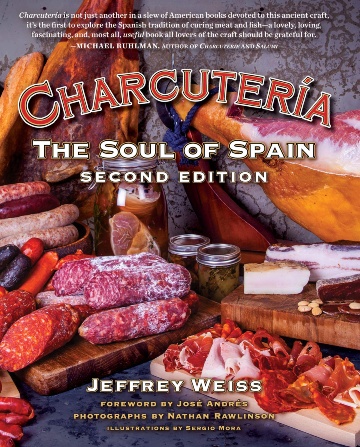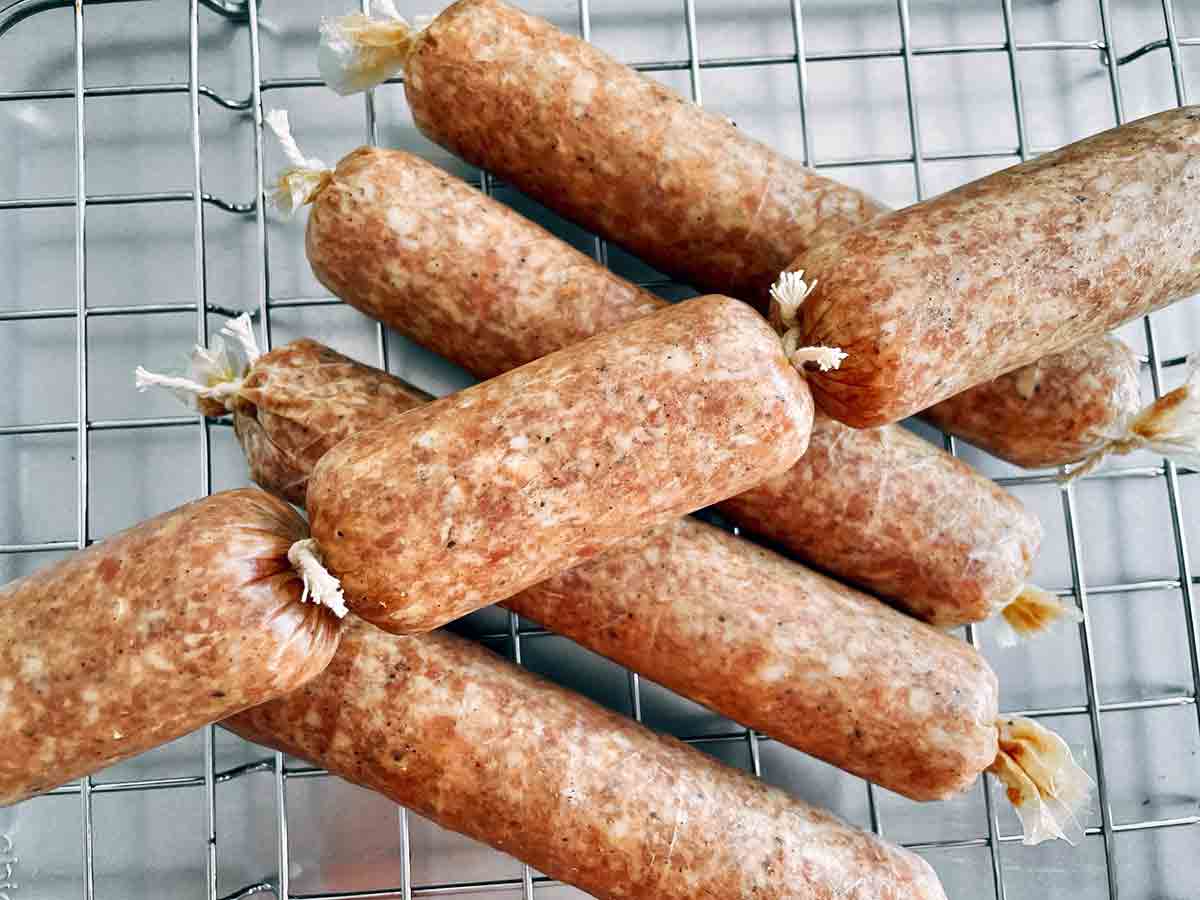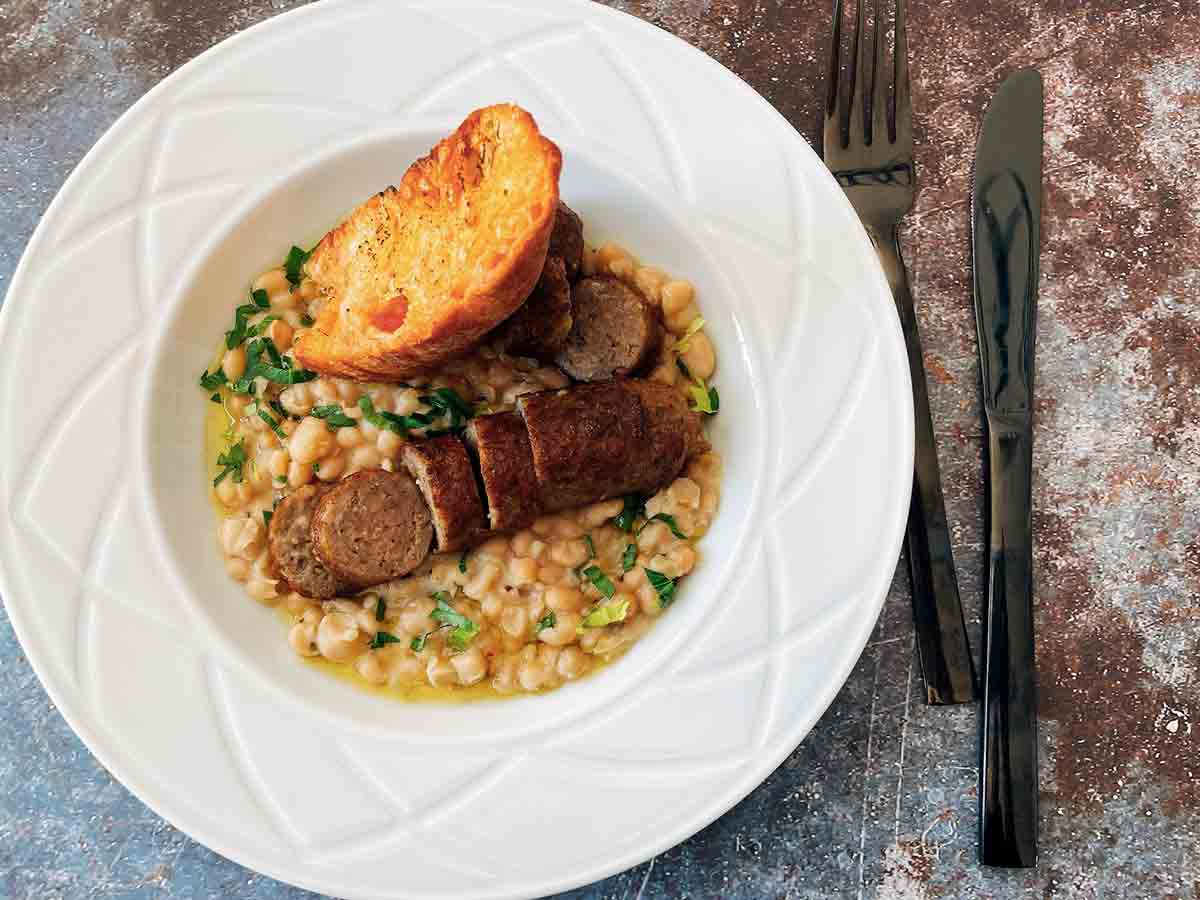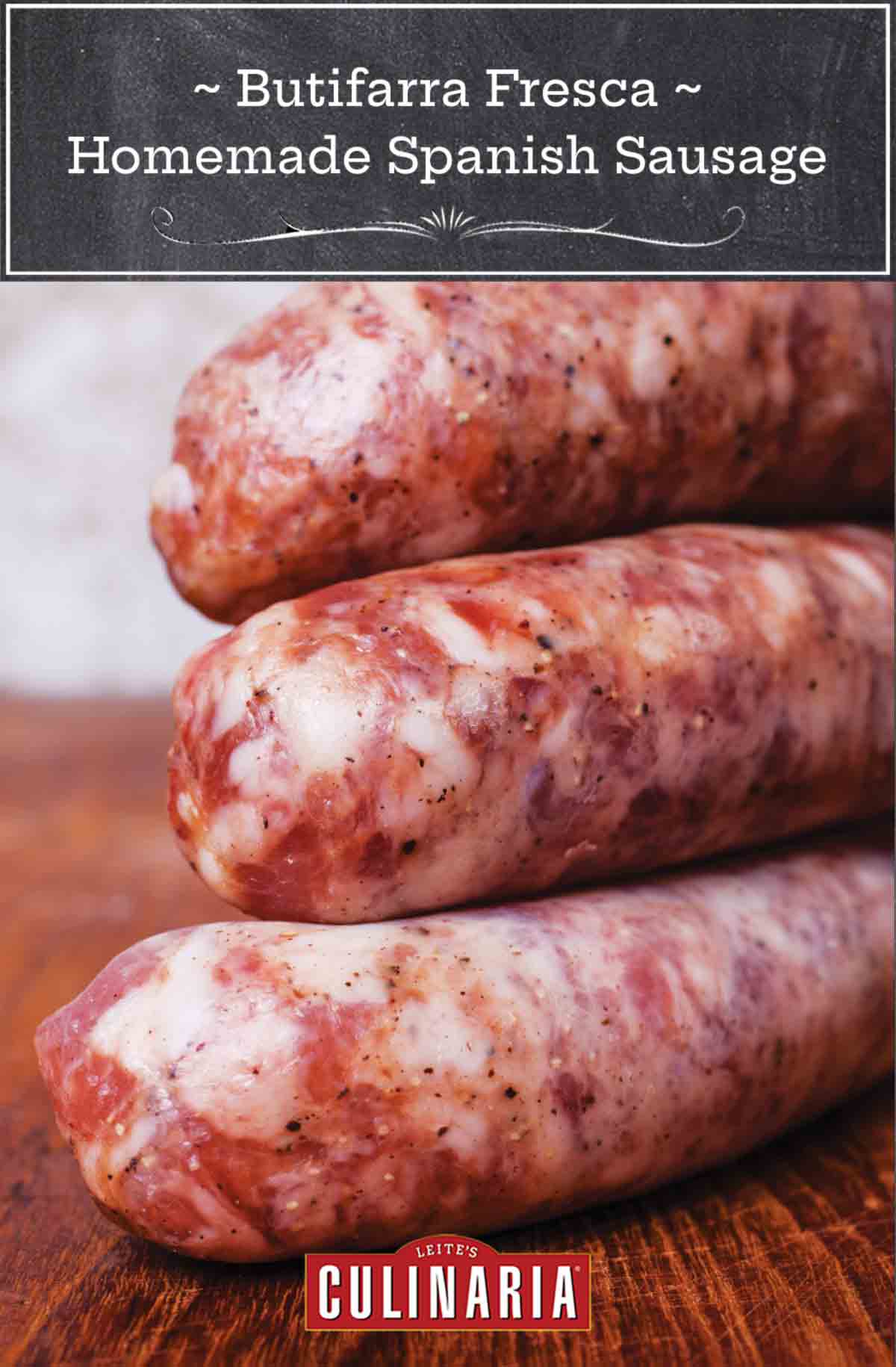
A basic white sausage that you will find most everywhere in and around Catalonia, this embutido has relatives all over the world, from the sweet and hot Italian sausages we have come to know in America, to the famous Toulouse sausages of France. Why?
Butifarra—or botifarra, in Catalan—is very closely related to the original sausage recipe mentioned in Apicius, the Roman culinary journal written around AD 900. In places like Barcelona, botifarra is a religion. There’s an annual fair in the butifarra’s honor every February at the famous Barcelona mercado La Boquería (the fair is called the butifarrada), and a ton of restaurants and shops in the market area serve the sausage in raw and cooked forms. (Check out La Botifarreria, near the Santa Caterina market. You’ll find a bigger sausage party there than at a Vegas strip club.) Each shop has its own proprietary mix of the sausage’s fat and lean content, different ratios of cuts of pork, and grind sizes.
Just know that Catalan purists thumb their noses at seasoning butifarra with anything other than salt and pepper. Anything else, in their opinion, interferes with your ability to taste the quality of the pork.
Want to Save This?
That said, we live in a global society, and modern Catalan chefs are creative people. As a result, these days you can find every flavor of the butifarra rainbow in Barcelona, from truffle to foie to pizza to even chocolate.
This recipe keeps it simple: salt and pepper. If you choose to buck tradition, consider some of the optional seasoning options in the recipe. They’re mostly Medici-based spices that work well alone or combined.–Jeffrey Weiss
Butifarra Fresca FAQs
You can. You basically have three options here. 1. Get a very sharp knife and get to chopping. This is the most time-consuming, labor-intensive process, and it’s a LOT of work to get it right. 2. If you have a solid, dependable, quality food processor, that will work. Cut your meat into cubes and work in small portions, and be certain to thoroughly combine all of your cuts (collar, belly, jowl) together. 3. Make friends with your local butcher and ask them to grind the meat for you. If you have a local butcher shop, you can likely special order the cuts pre-ground.
This special sausage is served like any other – pan-fried, grilled, used in soups, stews, or chilis, and although this is a very non-traditional approach, you can smoke it as well. Feel free to use it anywhere sausage is called for, such as Jamie Oliver’s sausage pappardelle.
Making your own sausage is a lot of work, be sure to store it carefully so that you’re able to enjoy every bit of it. Butifarra fresca will last about a week in the refrigerator, provided that it’s wrapped well. In the freezer, we suggest using vacuum-sealed packaging, as that will ensure freshness for about a year.

Butifarra Fresca ~ Fresh Sausage
Ingredients
For the sausage
- 2.2 pounds of the following blend of meats, cut into large cubes: 60% aguja (pork collar), 20% panceta (pork belly), and 20% papada (pork jowl)
- 2/3 ounce kosher salt
- 1/3 ounce freshly ground black pepper
- Scant 1/4 cup dry sherry, such as a fino, chilled
- 1/4 cup water, chilled
- 3 tablespoons extra virgin olive oil, for frying, divided
For seasoning (optional)
- 1 teaspoon ground cinnamon
- 1 teaspoon whole allspice, toasted and ground
- 1 teaspoon whole cloves, toasted and ground
- 1 teaspoon freshly ground white pepper
- 1/2 teaspoon freshly grated nutmeg
- 2 feet 1 1/4 –1 1/2-inch (32-mm–36-mm) hog casings, soaked, or more as needed
- Caul fat, as needed
Instructions
Make the sausage
- Place the aguja, panceta, and papada meats and meat grinder parts in the freezer for 30 minutes to par-freeze before attempting to grind.
- Combine the meats, salt, and pepper in a large mixing bowl. Toss together and set aside as you set up the grinder.
- Fill a large bowl with ice and place a smaller bowl inside the ice-filled bowl. Grind the meat mixture once through a medium-coarse (3/8 inch or 9.5 mm) die into the smaller bowl. (Be careful: The meat mixture is wet, so it may squirt and pop out of the grinder.)
Season the sausage
- In a small mixing bowl, combine the sherry, water, and any of the optional spices you choose, making a slurry. Keep the bowl containing the slurry chilled until ready to use.
- Place the ground meats in the bowl of a stand mixer fitted with the paddle attachment (or you can just mix in a mixing bowl with a sturdy spoon). Begin mixing on low speed. As the mixer runs, pour the sherry slurry into the bowl in a steady stream.
- Continue mixing on medium speed until the sherry slurry has been fully incorporated into the mixture, a white residue forms on the sides of the bowl, and the mixture firms up, 1 to 2 minutes. Place the bowl containing the ground meat mixture in the refrigerator to keep it cold until you are ready to stuff the sausage into casings.
Test the sausage
- In a small skillet over medium-high heat, warm 1 tablespoon of the oil. Place a small piece of the meat mixture in the skillet and fry until cooked through, about 2 minutes. Remove from the heat. Taste and adjust the seasonings to your liking.
Prepare the sausages
- If stuffing the sausages, stuff the mixture into the casings and tie into 12-inch (30 cm) loops or 6-inch (15 cm) links. Using a sterile pin or sausage pricker, prick each sausage several times. Place in the refrigerator to ferment overnight. Alternatively, you can ferment before stuffing your sausages.If not stuffing the sausages, form the mixture into 8 ounce (227 g) patties. Wrap in plastic wrap or caul fat, if using. Place in the refrigerator to ferment overnight.
Cook the sausages
- If cooking stuffed sausages, warm the remaining 2 tablespoons oil in a large skillet over medium-high heat and fry until they register an internal temperature of 150°F (65°C), 8 to 10 minutes. You can also oven roast or grill the sausages at 350°F (180°C) for 20 to 25 minutes, until they reach the same internal temperature.If cooking sausage patties, warm the remaining 2 tablespoons oil in a large skillet over medium-high heat and fry the sausage patties until they register an internal temperature of 150°F (65°C), 8 to 10 minutes.
- Remove the sausages from the heat and serve.

Explore More with AI
Nutrition
Nutrition information is automatically calculated, so should only be used as an approximation.
Recipe Testers’ Reviews
As much as I love to eat sausages, I love the individual nuances of flavour and ethnicity that define them. I also find the experience of making my own sausage incredibly rewarding, almost as pleasurable as eating them. Part of the pleasure is that of creating something that’s easily recognizable either through appearance or flavour. This sausage making activity also allows for creativity and making the end product one’s own. Above all, I love that when I make my own sausages I know exactly what’s in them.

So, what’s in my butifarro fresca? Well, starting with the meat, I used 600 grams of pork collar and 400 grams of pork belly. I was unable to procure the pork jowl. I’ve purchased pork jowl in the past from my butcher for other applications but I was going to have to place an order and be at their mercy for when it would be available. I thought it best to replace the pork jowl with pork belly.
As for spices, I used the recommended weight in cinnamon, allspice, white pepper, and nutmeg. All were freshly ground. I replaced the sherry with brandy and my hog casings were dried. I planned to use caul fat as this is a freezer item for me. However, I inadvertently used a smaller diameter grinding plate. After committing to this finer grind and mixing the ground pork, the meat was sufficiently emulsified to hold its shape.
For my own convenience, I fermented the ground spiced pork for 14 hours then stuffed into dried hog casings. These are my favourite casings as we usually don’t eat sausage casings and these are easily removed in the cooking process once the sausage has maintained its form. For testing purposes, I left one casing on but found that the sausage meat expanded at the ends while the casing didn’t. This made for a funny shaped sausage but was not a recipe flaw. Had I used fresh casings, this would have been avoided.

My yield was the equivalent of 8 links of approximately 120 grams each since I also made a few mini sausages for fun. I chose to fry these sausages but oven roasting would have also been superb. The flavours were balanced and the interior texture had this creamy bite of a well developed sausage. The exterior boasted a crispy golden brown and inviting colour.
This recipe scored a 12/10. I’m already planning my next batch. I served my sausages with braised cannellini beans and toasted Catalan tomato bread. We feasted Catalan style.











